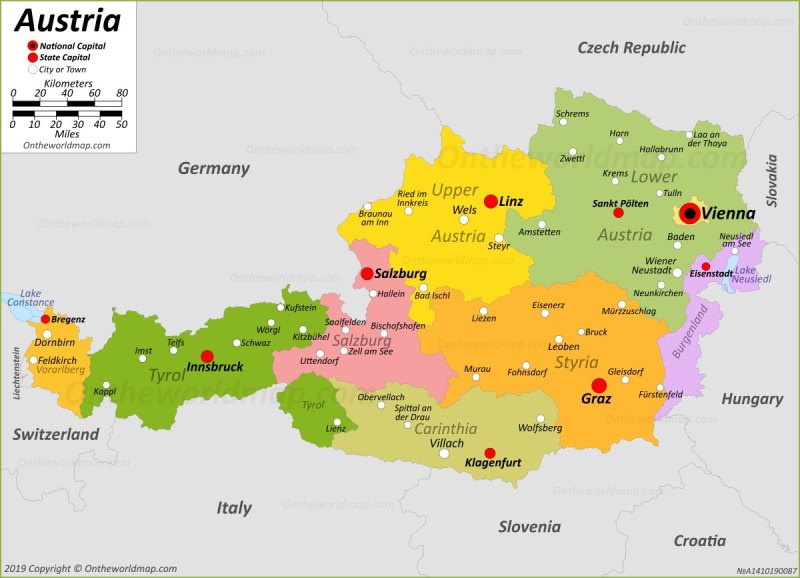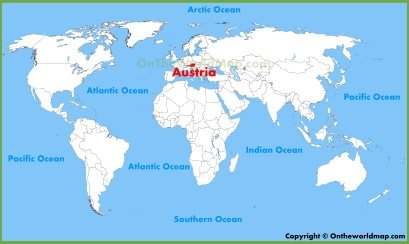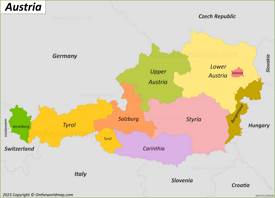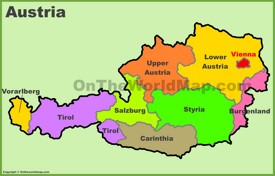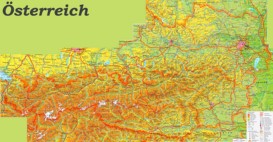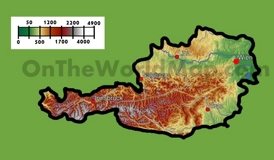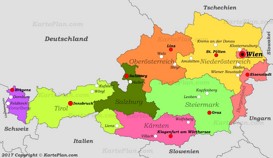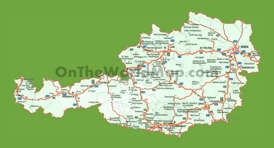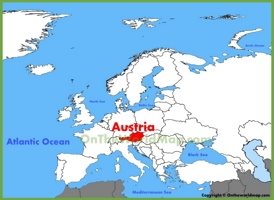Austria Map
Description:
This map shows governmental boundaries of countries; federal states, state capitals, lakes, major cities and towns in Austria.
Size: 1200x867px / 155 Kb | 1500x1083px / 453 Kb
Author: Ontheworldmap.com
Previous version of this map
You may download, print or use the above map for educational, personal and non-commercial purposes. Attribution is required. For any website, blog, scientific research or e-book, you must place a hyperlink (to this page) with an attribution next to the image used.
Online Map of Austria
Detailed Maps of Austria
About Austria
Austria, a landlocked country in Central Europe, is bordered by Germany and the Czech Republic to the north, Slovakia and Hungary to the east, Slovenia and Italy to the south, and Switzerland and Liechtenstein to the west.
Vienna, the capital and largest city, serves as the political, cultural, and economic center of Austria. The city is home to numerous international organizations, including the United Nations, and its population exceeds 1.9 million.
Other major urban centers include Graz, Linz, Salzburg, and Innsbruck, each contributing to the country's diverse economic and cultural fabric.
Tourism plays an important role in Austria's economy, attracting millions of visitors every year. The country's Alpine resort areas, world famous for their skiing and winter sports opportunities, attract tourists from all over the world.
Austria's rich architectural heritage further enhances its appeal as a tourist destination. Vienna fascinates tourists with attractions like Schönbrunn Palace, Hofburg and the historic center, which is a UNESCO World Heritage Site.
Salzburg, the birthplace of Mozart, attracts tourists with its baroque architecture and the legendary Hohensalzburg Fortress. Innsbruck, located in the Alps, attracts tourists with its unique combination of city and mountain scenery.
Austria has a highly developed and prosperous economy characterized by a strong industrial base and a significant service sector. The country has a strong manufacturing industry, in which industries such as mechanical engineering, transportation and chemicals play a key role. Due to its strategic position in Europe, Austria has a well-developed banking and financial services sector. The economy benefits from a well-educated workforce and a high standard of living.
Austria's commitment to environmental sustainability and renewable energy further sets it apart on the world stage. The country is investing in hydropower, wind and solar energy, reducing dependence on fossil fuels and contributing to a greener future. Austria's strategic focus on education and research fosters innovation and technological advancement, ensuring the country's continued economic growth and competitiveness.
Austria is thus a highly developed Central European country characterized by a dynamic economy, vibrant cities and a thriving tourism industry. Its strategic location as well as its commitment to sustainability and innovation make Austria a key player on the European and global stage.
The Facts:| Capital: | Vienna |
| Area: | 32,383 sq mi (83,871 sq km) |
| Population: | ~ 9,050,000 |
| Official language: | Austrian German |
| Official regional languages: | Hungarian, Slovene, Burgenland Croatian. |
| Religion: |
64.1% Christianity - 55.2% Catholicism - 5.1% Orthodoxy - 3.8% other Christian 26.4% no religion 8.3% Islam 1.2% other |
| Currency: | Euro (€) (EUR) |
| Driving side: | right |
| Calling code: | +43 |
| Internet TLD: | .at |
| Time zone: | UTC+1 (CET) Summer (DST) UTC+2 (CEST) |
| Official government website: | www.bundeskanzleramt.gv.at |
| Official tourism website: | www.austria.info |
Google Map of Austria
Largest cities: Vienna, Graz, Linz, Salzburg, Innsbruck, Klagenfurt, Villach, Wels, Sankt Pölten, Dornbirn, Wiener Neustadt, Steyr, Feldkirch, Bregenz, Leonding, Klosterneuburg, Baden, Wolfsberg, Leoben, Krems, Traun, Lienz.
Ski Resorts in Austria: Alpbach, Arlberg, Axamer Lizum, Bad Gastein, Bad Hofgastein, Brixental, Dachstein-West, Dorfgastein, Ellmau, Fieberbrunn, Filzmoos, Galtür, Grossarl, Heiligenblut, Hinterglemm, Hinterstoder, Hintertux, Hochkönig, Ischgl, Kappl, Kaprun, Katschberg, Kitzbühel, Kreischberg, Lachtal, Lech, Leogang, Lungau, Maria Alm, Mayrhofen, Montafon, Nassfeld, Obergurgl, Obertauern, Pitztal, Saalbach, Schladming, Seefeld, Semmering, SkiWelt, Sölden, Söll, Sportgastein, St. Anton, Stubai, Stuhleck, Tauplitz, Turracher Höhe, Warth, Westendorf, Zell am See, Zell am Ziller, Zillertal.
Main sights of Austria: Schönbrunn Palace, Hofburg, Belvedere Palace, Vienna State Opera, St. Stephen's Cathedral, Hallstatt-Dachstein / Salzkammergut Cultural Landscape, Salzburg Altstadt, Innsbruck Altstadt, Kitzbüheler Horn, Melk Abbey, Hochosterwitz Castle, St. Wolfgang, Krimml Falls, Eisriesenwelt, Schloss Esterházy (Eisenstadt), Schafberg, Hohenwerfen Castle.
Federal states of Austria
| Federal state | Capital | Area | Population |
|---|---|---|---|
| Burgenland | Eisenstadt | 1,531 sq mi (3,965 sq km) | 302,000 |
| Carinthia | Klagenfurt | 3,682 sq mi (9,536 sq km) | 570,000 |
| Lower Austria | Sankt Pölten | 7,405 sq mi (19,178 sq km) | 1,700,000 |
| Salzburg | Salzburg | 2,762 sq mi (7,154 sq km) | 563,000 |
| Styria | Graz | 6,332 sq mi (16,401 sq km) | 1,255,000 |
| Tyrol | Innsbruck | 4,883 sq mi (12,648 sq km) | 775,000 |
| Upper Austria | Linz | 4,626 sq mi (11,982 sq km) | 1,530,000 |
| Vienna | - | 160 sq mi (415 sq km) | 1,950,000 |
| Vorarlberg | Bregenz | 1.004 sq mi (2,601 sq km) | 402,000 |
Geography of Austria
Austria's geography is characterized by a diverse landscape, predominantly mountainous, with the Eastern Alps occupying about 62% of its territory. The country is divided into five main regions: the Alps, the Alpine foothills, the Pannonian Basin, the Bohemian Massif and the Vienna Basin. Each region has unique geographical characteristics that affect the local climate and ecosystems.
The Alps dominate the western and southern parts of Austria, offering rugged terrain and high peaks such as the Großglockner, the highest mountain in the country at 3,798 meters. The Alpine Foothills, located north and east of the Alps, consists of rolling hills and fertile valleys where agriculture and viticulture are developed. The Pannonian Basin, located in the easternmost part of Austria, is characterized by flat plains and a continental climate characterized by hot summers and cold winters.
Austria has a temperate climate with pronounced seasonal variations. The western regions receive more precipitation, while the eastern regions are characterized by drier conditions. Winters in the alpine regions are accompanied by snow, which favors winter sports, while summers remain mild, especially in the mountainous areas.
Bordering Countries: Germany, Switzerland, Italy, Czech Republic, Slovakia, Hungary, Slovenia, and Liechtenstein.
Major Rivers: Danube, Rhine, Leitha, Drava Mur, Inn, Morava, Isar, Rába, Lech, Enns, Kamp, Thaya, Steyr, Salzach, Bregenzer Ach, Ranna, Wattenbach, Neualmbach, Loisach, Gurk, Großache, Erlauf.
Lakes of Austria: Bodensee (Lake Constance), Neusiedler See, Attersee, Traunsee, Wörthersee, Mondsee, Millstätter See, Wolfgangsee, Ossiacher See, Hallstätter See, Achensee, Weissensee, Wallersee, Obertrumer See, Zeller See, Grundlsee, Irrsee, Mattsee, Plansee, Fuschlsee, Faaker See, Altausseer See, Neufelder See, Old Danube, Lange Lacke, Heiterwanger See, Grabensee, Keutschacher See, Illmitzer Zicksee, Zicksee, Klopeiner See.
Mountain Ranges: High Tauern, Ötztal Alps, Zillertal Alps, Stubai Alps, Glockner Group, Rieserferner Group, Schober Group, Silvretta, Venediger Group.
Highest mountains in Austria: Großglockner (3,797m), Wildspitze (3,772m), Kleinglockner (3,770m), Weißkugel (3,739m), Pöschlturm (3,721m), Hörtnagelturm (3,719m), Hofmannspitze (3,711m), Weitzenböckturm (3,702m), Draschturm (3,701m), Gerinturm (3,700m), Glocknerhorn (3,680m), Teufelshorn (3,677m), Großvenediger (3,674m), Hinterer Brochkogel (3,628m), Hintere Schwärze (3,628m), Similaun (3,606m), Großes Wiesbachhorn (3,564m), Rainerhorn (3,560m), Ötztaler Urkund (3,556m), Marzellspitze (3,555m), Ramolkogel (3,550m), Schalfkogel (3,540m), Watzespitze (3,533m), Hochvernagtspitze (3,530m), Langtaufererspitze (3,529m), Weißseespitze (3,526m), Mutmalspitze (3,522m), Fineilspitze (3,516m), Innere Querspitze (3,515m), Hochfeiler (3,510m), Teufelskamp (3,509m), Romariswandkopf (3,508m), Zuckerhütl (3,505m), Hohes Aderl (3,504m), Fluchtkogel (3,500m).
Brief History of Austria
Austria's history reflects a complex evolution of political and cultural influences. The region first emerged as a significant entity during the Roman Empire, acting as a frontier province. In the early Middle Ages, the Babenberg dynasty established its control here, laying the foundation for further development. The Habsburgs came to power in the late 13th century, turning Austria into a dominant force in European politics.
Under Habsburg rule, Austria expanded its influence, becoming a central component of the Holy Roman Empire and then the Austro-Hungarian Empire. The collapse of the empire after World War I led to the establishment of the First Austrian Republic in 1918. Austria experienced political turmoil in the interwar period, culminating in its annexation by Nazi Germany in 1938.
After World War II, Austria once again became a sovereign state, taking a neutral position during the Cold War. In 1995, the country joined the European Union, strengthening its role in European integration. Austria's history attests to its strategic importance in European affairs and its resilience in adapting to changing geopolitical landscapes.

